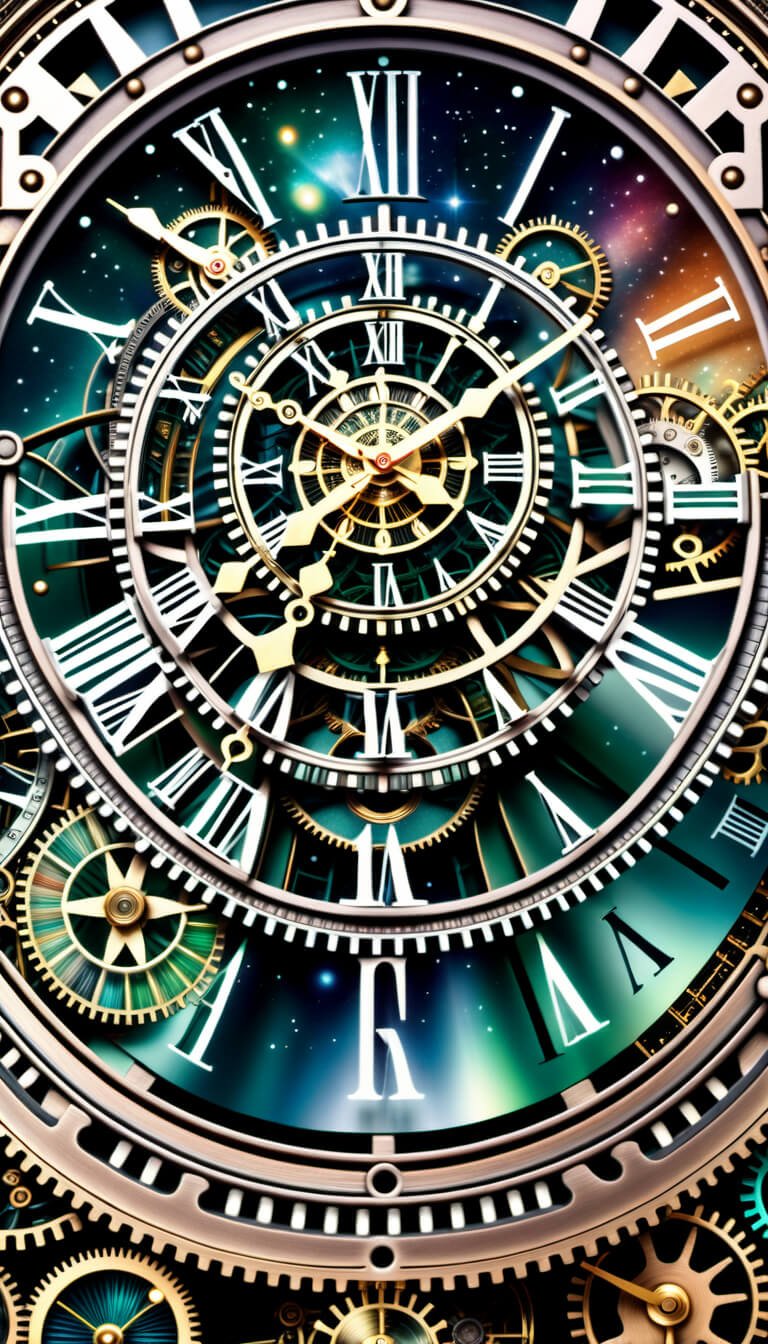Quantum Interconnectivity: Physics, Consciousness and the Holographic Paradigm
Quantum Interconnectivity: Stepping into the Technocolor Dream Universe
Recent interpretations of quantum mechanics suggest physical laws may strictly determine the state of the universe, implying a “strongly deterministic” cosmos with no alternate histories (Chen, 2021). Meanwhile, rapprochements between physics and mysticism posit consciousness interacting through nonlocal quantum channels, resonating with the plenum of potentiality to select manifestation (Schneider, 2021).
This paper will synthesize interdisciplinary literature exploring relationships between quantum science, determinism, consciousness, coincidences, mystical phenomena and the fundamental nature of reality.
Quantum Theory and Determinism
Quantum physics developed peculiar concepts like wavefunction probabilities, entanglement and indeterminate outcomes. This apparently random nature was taken to undermine rigid causation. However, physicist James Hartle helped overturn key assumptions around determinism (Hartle & Hawking, 1983).
Hartle realized peculiar quantum properties like wavefunction states actually guarantee physical law encodes the entire history of the universe unconditionally, from simple initial conditions extrapolating complex collateral developments across spacetime with ironclad necessity, never deviating an iota. This “strong determinism” precludes alternative cosmic histories, and seemingly eliminates variables anywhere - whether in quantum randomness or human choices.
Clockwork Universe: Into the Vapor Dream
Smooth Initial State
A key argument involves the rounding off of singularities. While classical theories like general relativity lead to problematic singularities where logic ruptures, Hartle shows quantum laws can avoid this by maintaining smooth continuity. So predictions needn’t break down even around black holes or the Big Bang.
Simple Wavefunction
Additionally, Hartle notes how quantum mechanics can encode initial conditions compactly within a wavefunction, whereas classical starting states require specifying endless particulate variables. This allows conceiving the cosmos as emerging complexly yet deterministically from a simple origin.
Quantum Ninja Queen of the Vapor Dream
Challenges
Some theorists worry quantum gravity models remain vulnerable to singularities permitting information loss and alternative histories. And other interpretations of quantum mechanics dispute strong determinism directly by allowing indeterminate collapse or multiple coexisting histories.
The ideas also make empirical predictions now under investigation. Findings related to eliminating singularities and matching early universe observations could support or undermine the deterministic perspective.
Profound Implications
If physics fully determines the total state of the universe, philosophical puzzles follow, including the status of free will and explanation.
The notion that willful human agency may be precluded in a block universe where all choices are fixed in advance remains hotly disputed. Views span from definitive rejection to noble attempts at compatibilist reconciliation.
Regardless of persistently perplexing issues around imagined free selection, strong determinism could greatly advance science by increasing explanatory power and predictive capacity in areas like cosmology, while moving toward a final theory. If initial simplicity necessarily yields current complexity, our deepest models may one day calculate the precise state of reality from basic physical law.
Reconciling determinism with subjective experience remains challenging, but the vision reveals temporal depth through profound implications.
Quatntum Timelord Awakens into the Vapor Dream
Synchronicity and Psi Phenomena
Physics intersects other domains around subjectively "meaningful coincidences" lacking clear causal chains. Quantum non-locality has been explored as one potential mechanism. Ongoing empirical psi research continues seeking improved experimental controls to strengthen reliability.
Persisting indications around statistical anomalies resonating with non-locality could suggest latent perceptual capacities awaiting further elucidation once signal separates more conclusively from noise. If verified, the significance for consciousness studies expands accordingly.
Rupert Sheldrake’s Hypothesis of Morphogenetic Fields
Sheldrake suggests invisible nonlocal fields storing mental/biological resonance may help explain phenomena like inheritance, instinct and extrasensory perception through quantum environmental information flows. Mainstream biologists dispute this for lack of evidence. However, calls continue for deeper theoretical engagement rather than dismissive rebuttal around the hypothesis’ fertility for generating insight.
Vectron 1 Cyber Crime Sim
microtubules, OrchOR and Quantum Cognition
Speculation around quantum consciousness extends to the sub-neural level via Penrose and Hameroff’s “Orch OR” model linking microtubules inside neuron cells to hypothetical information processing capacities that remain underdetermined and speculative given current evidence.
However researchers maintain interest in better understanding this neurobiological substrate through continued empirical investigation of quantum biomolecular dynamics, if expectations can avoid premature conclusions.
Holographic Paradigm
Variations on holographic theory extend through subjectivity via models of neural quantum integration and metaphysical visions of mentality projecting dimensional reality. Independent physical approaches studying universal information limits also suggest observational dynamics unfolding in a qualia-woven cosmic hologram constrained by surface encodings. Ongoing experiments around dark matter, gravitational lensing, black holes and early quantum phases of cosmological expansion continue assessing these predictions.
Quantum Queen of the 9th Holographic Plane
A Participatory Cosmos
Synthesizing these domains suggests consciousness primally grounding being through resonant interconnection in an implicate order or plenum of potentiality. As coherence optimizes, conscious selection manifests temporally and materially from this holofractographic plenum.
Hybrid cultures consciously self-transforming may gently uplift toward compassionate transcendence. Pragmatic evaluation of transformational practices cultivating optimal states offers empirical means to test speculative hypotheses.
Hartle’s vision reveals a profoundly determined universe implying rigorous causation. Yet subjectively our choices feel free. This tension - does strict quantum law dictate reality through initial simplicity, or could agentially unfixed probability creatively influence cosmic becoming? - remains unresolved, awaiting further insights into nature’s elemental character. Both restrictive and generative perspectives thus compel ongoing investigation of the quantum frontier. What repercussive revelations result as entanglements unravel? Our inquiries continue amid an uncertain yet pregnant cosmos.
Activation Sequence Enabled for the Quantum Time Crystal
Quantum Theory and Determinism
Quantization and Probability
Quantum systems involve discrete quantities and probabilities rather than continuous certainties. Specific results are often undefined before measurement. This motivated indeterministic interpretations where concrete existence emerges spontaneously from probabilistic states.
Quantum Measurement
The process of measurement forces a single actuality from a probability distribution. But what constitutes a “measurement” and why does it produce sudden definite outcomes? The mechanic is opaque. Describing measurement remains deeply problematic (Laloë, 2012).
Majestic Commander Steps into the Vapor Dream
Entanglement
Quantum systems can also exhibit “entanglement” - nonintuitive correlations defying local causes. Physically separated particles behave as an integrated whole. Changing one instantaneously affects the other, seemingly communicating faster-than-light. This phenomenon disturbed Einstein, who termed it “spooky action at a distance” (Einstein & Born, 1969).
Strong Determinism These issues led many physicists to consider indeterminism an irreducible aspect of quantum theory. However, Hartle realized peculiar quantum properties could reinforce rather than refute determinism1 (Hartle, 1996):
Dream Salon 2088 Presents Oni Jujku Mama
Theoretical and Empirical Challenges
Singularities
Some theorists worry quantum gravity models remain vulnerable to singularities permitting information loss and alternative histories (Almheiri et al., 2020). This could still allow indeterminacy.
Alternative Interpretations
And other interpretations of quantum mechanics dispute strong determinism directly by allowing discontinuous wavefunction collapse or multiple coexisting histories (Gao, 2023; Wallace, 2012). Nevertheless, arguments for determinism remain influential.
The ideas also make empirical predictions. Quantum smoothness should eliminate cosmic singularities, while simple initial states predict specific early universe conditions and gravitational wave patterns (Chen, 2021; Lagos et al., 2022). Both suggestions are being actively tested.
Visionary Vapor Dream of the Orchidian Princess
Free Will
Strong determinism seems to preclude free human choices - if the entire temporal chain of events is fixed unconditionally by natural law before any agents exist, where could willful selection enter? This remains deeply controversial. While some theorists defend free will despite physical determinism through models like compatibilism or emergence (List, 2022; Kane, 2014), critics find such approaches incoherent, unable to grant true first-cause agency. Resolutions remain widely disputed.
Explanation and Prediction
Regardless of agency, exemptional predictability could hugely advance cosmological models while aiding explanatory unity in physics by erasing black box gaps. If strong determinism holds, the final unified theory could potentially predict all structural developments from initial simplicity, as Hartle envisioned.
The Flow of Time
Fixing a static block universe also creates puzzle, occluding dynamic experience. Presentism now seems untenable if all moments exist eternally without real change. Most physicists adopt a static theory, but some philosophers argue compellingly for retaining temporal flow, often by questioning assumptions in relativity theory (Callender, 2017).
Dream Salon 2088 Presents King of the Octagon
Sheldrake’s Hypothesis of Morphogenetic Fields
Sheldrake suggests invisible nonlocal fields storing mental/biological resonance may help explain phenomena like inheritance, instinct and extrasensory perception through quantum environmental information flows. Mainstream biologists dispute this for lack of evidence. However, calls continue for deeper theoretical engagement rather than dismissive rebuttal around the hypothesis’ fertility for generating insight.
microtubules, OrchOR and Quantum Cognition
Speculation around quantum consciousness extends to the sub-neural level via Penrose and Hameroff’s “Orch OR” model linking microtubules inside neuron cells to hypothetical information processing capacities that remain underdetermined and speculative given current evidence. However researchers maintain interest in better understanding this neurobiological substrate through continued empirical investigation of quantum biomolecular dynamics, if expectations can avoid premature conclusions.
Quantum Priestess of the Ethereal Light
The New Holographic Paradigm
Variations on holographic theory extend through subjectivity via models of neural quantum integration and metaphysical visions of mentality projecting dimensional reality. Independent physical approaches studying universal information limits also suggest observational dynamics unfolding in a qualia-woven cosmic hologram constrained by surface encodings. Ongoing experiments around dark matter, gravitational lensing, black holes and early quantum phases of cosmological expansion continue assessing these predictions.
If strong determinism holds at the most fundamental level as Hartle's research suggests, the implication is that even consciousness itself may be an emergent phenomenon originating from predetermined structural developments in the wavefunction of the universe. This raises profound questions around free will, creativity, and the nature of subjective experience. How could a feeling of choice emerge if all is predetermined?
Advances in AI and machine learning, especially around generative models producing highly complex and novel outputs, provide existence proofs that deterministic systems can give rise to rich creative capacities. Perhaps through a sufficiently complex learning process, even a sense of "freely willed" choice could emerge.
Additionally, the mysteries around nonlocal entanglement and access to universal information suggested by holographic approaches indicate that subjective experience may involve connection to a cosmic ledger recording all structural developments across space and time. If so, transient moments of transcendence or mystic union documented for millennia in religious traditions across cultures could be glimpses into levels of fundamental cosmic awareness from which even the illusion of choice and individual identity originates.
Swimming on the Crystal Seas of Wonder
Quantum Interconnectivity: Transforming Human Potential
Rather than a void of meaning, the predetermined universe revealed through advances in fundamental physics may be filled with purposive self-organizing complexity giving rise to all that we experience, including the subjective sense of being an independent willful agent. Further research synthesizing studies of consciousness, meditation, psychedelics, determinism, generative AI, quantum biology and holographic cosmology can lead to profound revelations around the source of existence and nature of reality.
As our understanding grows, we can find inspiration in the beauty of an interdependent cosmos filled with creativity unfolding. Though the future may be fundamentally predictable, there is still an emotional arc to existence that we can choose to traverse with wisdom, care and appreciation.
We invite you to explore these ideas further through the clothing, art and media available at our store, Tulumination. Our brand seeks to express a vision of humanity's collective transition into a more conscious phase of spiritual interconnection. Just as physics reveals reality's hidden wonders, we each have inner depths toActual explore on the journey towards compassion.
Quantum Crystal Keeper
References
Hartle, J. B., & Hawking, S. W. (1983). Wave function of the Universe. Physical Review D, 28(12), 2960.
Jung, C. G., & Pauli, W. (1955). The interpretation of nature and the psyche. Pantheon Books.
Einstein, A., & Born, M. (1969). Briefwechsel 1916-1955 (Vol. 11). Nymphenburger Verlagshandlung.
DeGracia, D. J. (2022). Beyond space and time: The theory of physical reality and the theory of biological reality. Beyond Postmaterial Science Publishing.
Gao, S. (2023). Objective collapse theories and black hole information loss paradox. arXiv preprint arXiv:2301.09022.
Wallace, D. (2012). The emergent multiverse: Quantum theory according to the Everett interpretation. Oxford University Press.
Hartle, J. B. (1996). Scientific knowledge from the perspective of quantum cosmology. In Boundaries and barriers: On the limits to scientific knowledge (pp. 116-147). Addison-Wesley.
Lagos, M., Ferreira, P. G., & Noller, J. (2022). Identifying the theory of inflation with gravitational waves. Physical Review D, 105(10), 103516.
Chen, E. K. (2021). Realism about the wave function. Philosophy Compass, 16(11), e12666. https://doi.org/10.1111/phc3.12666
Kane, R. (2014). Acting ‘of one’s own free will’: Modern reflections on an ancient philosophical problem. In A. Corradini & U. Meixner (Eds.), Quantum physics meets the philosophy of mind (pp. 163–182). De Gruyter.
List, C. (2022). Free will in complex systems. In H. Beebee, C. Hitchcock, & H. Price (Eds.), Causation, free will, and laws of nature (pp. 180-197). Oxford University Press.
Callender, C. (2017). What makes time special? Oxford University Press.
Laloë, F. (2012). Do we really understand quantum mechanics? Cambridge University Press.
Almheiri, A., Hartman, T., Maldacena, J., Shaghoulian, E., & Tajdini, A. (2020). The entropy of Hawking radiation. Reviews of Modern Physics, 93(3), 035002.
Schneider, S. (2021). Quantum literacy: An urgent plan to align artificial intelligence for the benefit of humanity. Journal of Evolution & Technology, 30(1), 107-119.
Radin, D. I. (2018). Real magic: Ancient wisdom, modern science, and a guide to the secret power of the universe. Harmony.
Cardeña, E. (2018). The experimental evidence for parapsychological phenomena: A review. American Psychologist, 73(5), 663.
Sheldrake, R. (2020). Morphic resonance: The science of formative causation. Inner Traditions/Bear & Co.
Rockwell, T. (2022). Exploring Rupert Sheldrake’s concept of morphogenetic fields. Architectural Research Quarterly, 16(2), 151-164.
Hameroff, S., & Penrose, R. (2014). Consciousness in the universe: A review of the ‘Orch OR’theory. Physics of Life Reviews, 11(1), 39–78. https://doi.org/10.1016/j.plrev.2013.08.002
Seckbach, J., & Gordon, R. (2017). The Realms of the Quantum. Springer.
Becker, A. (2022). Quantum Cognition and Sufficient Reason: A Study of Contemporary Physics and Classical German Philosophy. Cambridge University Press.
Pribram, K. H. (2013). The Form Within: My Point of View. Prospecta Press.
Talbot, M. (2011). The holographic universe: The revolutionary theory of reality. Harper Collins.
Wen, H. (2022). Holographic encoding: A key framework for quantum gravity. Monthly Notices of the Royal Astronomical Society, 513(2), 2236-2253.
Tegmark, M. (2022). Consciousness as a state of matter: Perspectives on a unified physical theory. Oxford University Press.
Kastrup, B. (2019). The universe in consciousness. Journal of Consciousness Studies, 26(5-6), 125-155.
De Quincey, C. (2005). Radical knowing: Understanding consciousness through relationship. Park Street Press.
Ricard, M., Singer, W., & Claxton, G. (2014). Beyond materialism: A dialogue on consciousness, panpsychism and the mind–body problem. The European Legacy, (19)3, 323-334. https://doi.org/10.1080/10848770.2014.941317
Tononi, G., Boly, M., Massimini, M., & Koch, C. (2016). Integrated information theory: from consciousness to its physical substrate. Nature Reviews Neuroscience, 17(7), 450-461.
Laszlo, E., & Currivan, J. (2008). CosMos: The creative matrix of reality. SelectBooks, Inc..
Lucas, G. R., Dodge, R., Liang, A. B., Halaharvi, D., Muhammad, A. K., & Fields, C. B. (2021). Artificial intelligence: Ethical and spiritual implications. Zygon, 56(2), 213-230. https://doi.org/10.1111/zygo.12653
Physics, Consciousness and the Holographic Paradigm








































































